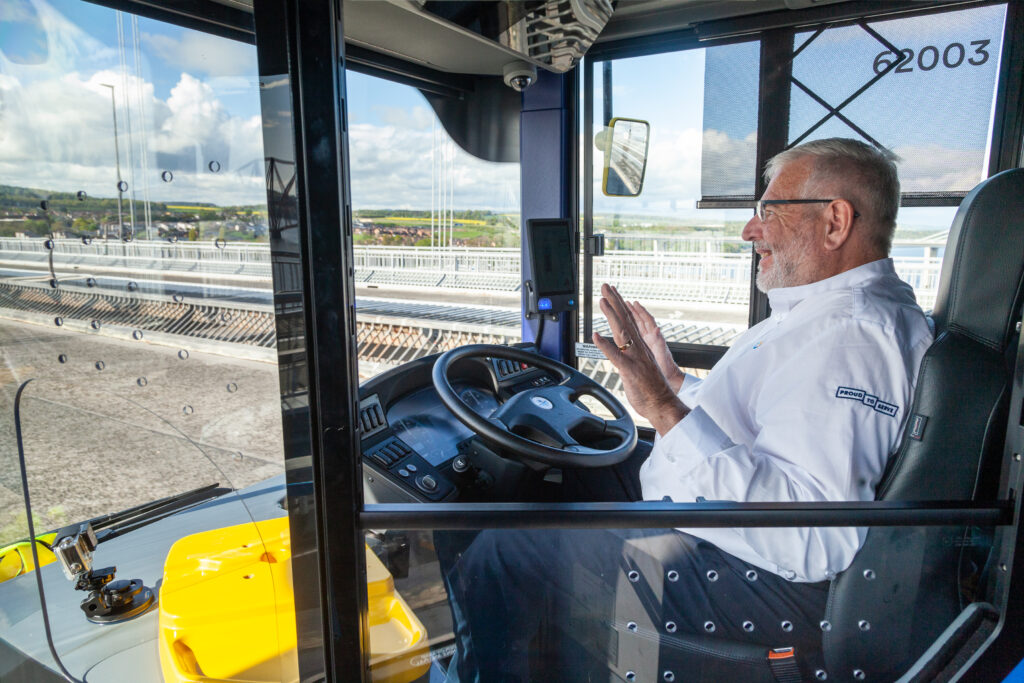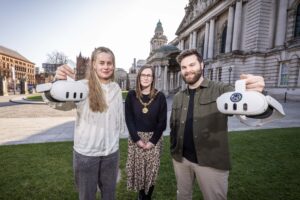Self-driving fleet of five buses now serving 14-mile route, seven days a week.
A new scheduled passenger service has started up in Scotland. The AB1 route provides the first direct public transport link between Fife and the business and retail sites at Edinburgh Park, with the capacity to carry up to 10,000 passengers a week. But what makes the service unusual is that buses drive themselves.

In fact, this CAVForth project is thought to be the world’s first registered bus service using full-sized autonomous buses. It’s part of a trial running until 2025, demonstrating autonomous technology in a real-world environment.
The buses will travel in mixed traffic at up to 50mph. Normal bus fares apply.
CAVForth operates at the highest level of autonomous vehicle technology currently permissible on public roads, SAE Level 4, which requires the buses to retain a safety driver. Stagecoach East Scotland has recruited an additional 20 staff.
As well as this safety driver, the buses in the trial will also have a second member of staff – a ‘bus captain’ who can move freely around the vehicle and engage with passengers, supporting the trial’s aim to engage with the public and answer any concerns.
The idea is also to show what a what a future service might feel like, where a single bus captain can leave the cab and let the computer do the driving.
So how does the system work?
The new buses run Fusion Processing’s autonomous drive system, CAVStar. This uses data received from sensors including cameras, lidar and radar, which with AI processing delivers optimum efficiency in all traffic conditions.
The 14-mile route is made up of A-roads, motorways, bus lanes and private land. It includes complex traffic manoeuvres such as roundabouts, traffic lights and motorway lane changes. The route also crosses the Forth Road Bridge.
What’s more, each bus receives information directly from traffic light systems so can adjust speed accordingly – allowing for a smoother run. This kind of intelligent, autonomous driving reduces unnecessary braking and acceleration, which in turn leads to less wear on brakes and tyres and corresponding reductions in particulate emissions.
The trial follows almost 10 years of research and development by Fusion Processing. Its CAVStar system has covered more than 1,800km in tests.
The Alexander Dennis Enviro200AV buses are derived from the manufacturer’s standard Enviro200 single decker. It’s a tried and tested platform for the new technology, as more than 8,000 of these buses already operate across the UK – with human drivers.
The ambitious CAVForth project is led by Fusion Processing Ltd in co-operation with project partners Stagecoach, Transport Scotland, Alexander Dennis, Edinburgh Napier University and Bristol Robotics Laboratory. It is co-funded by the UK government’s Centre for Connected and Autonomous Vehicles.
Jim Hutchinson, CEO of Fusion Processing, says: ‘CAVForth is an exciting showcase of how our CAVstar Automated Drive System can safely operate in a very complex driving environment. This pilot is globally significant and marks a step change in the operation of autonomous commercial vehicles on public roads.’
Kevin Stewart, Minister for Transport, adds: ‘We want Scotland to continue to be at the forefront in the development of connected and autonomous vehicles and the start of this live trial will really help the country establish its credentials on the world stage. I am excited to see how this technology can help to support our vision for a sustainable, inclusive, safe and accessible transport system.’
Anthony Pipe, Professor of Robotics and Autonomous Systems at the Bristol Robotics Laboratory, says: ‘Bristol Robotics Laboratory is very proud to be involved in this ground-breaking project, which is taking a world-lead on advanced automation for the public service vehicle sector. The short-term benefits of vehicle autonomy in providing safer and more energy efficient travel will be illustrated by this project and, in the longer term, we believe that it will contribute significantly to transformations in the way we achieve mobility in our society.’
In related news, new SMMT data shows 40.7 million vehicles on British roads – the highest figure ever – but electric vehicles and other tech has cut average CO2 emissions.
Photo courtesy of Alexander Dennis
















Leave a Reply